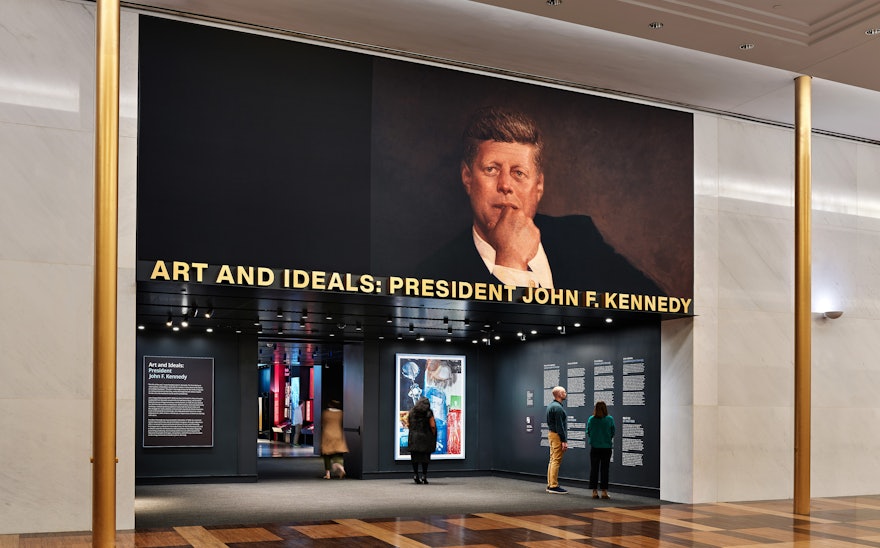President John F. Kennedy believed in the vital role of the arts in American life as sincerely as he believed in public service. This link is explored in Art and Ideals: President John F. Kennedy, the first permanent exhibition at the John F. Kennedy Center for the Performing Arts in Washington, DC. Pentagram developed the creative direction and design of the exhibition, which marks its 50th anniversary season.
As a living memorial the Kennedy Center honors President Kennedy’s legacy and celebrates his commitment to the arts. The exhibition establishes an interpretive space at the Center that explores President and First Lady Jacqueline Kennedy’s connection with literature, performance, and the visual arts, reminding visitors of their importance to a democratic society.
“Above all, we are coming to understand that the arts incarnate the creativity of a free people. When the creative impulse cannot flourish, when it cannot freely select its methods and objects, when it is deprived of spontaneity, then society severs,” wrote President Kennedy.
The first of its scope in Kennedy Center history, the exhibition was designed and produced in collaboration with architects KieranTimberlake, consulting curator Ileen Gallagher, and an advisory committee of five leading U.S. historians, who helped establish the focus of the narrative and relate Kennedy’s ideals to the Center’s ongoing work. This group included the Pulitzer Prize-winning Harvard professors Fredrik Logevall and Annette Gordon-Reed; the cultural diplomacy and Cold War expert Penny von Eschen; the University of Texas civil rights scholar Peniel Joseph; and the cultural historian and Pulitzer Prize finalist Scott Sandage.
Located on the terrace level of the original Edward Durell Stone building, a 7,500 sq. ft former atrium space has been dramatically renovated and repurposed to house the new exhibition. The exhibition is divided into four areas that link the arts to democracy, social change, culture and the White House itself. Kennedy was renowned as a powerful orator, and these themes are explored through his eloquent writing and speeches.
Pentagram’s design features a dramatic architectural frieze of LEDs that allows visitors to experience Kennedy’s powerful speeches and his obvious love of language. The media components were developed in collaboration with Batwin + Robin Productions, incorporating photography, text, and archival footage. Words from Kennedy’s speeches run along the top of the walls, and at moments the room pauses and dims to focus on his most important speeches, dramatized by special montages that bring his words to life.
A series of three interactive experiences were developed with TheGreenEyl’s Richard The and his team. “Dinner at the White House” features a series of touchscreen “plates” that represent the prominent cultural figures who attended Kennedy dinners. “The Power of Words” presents keywords from landmark Kennedy speeches on a mirrored wall, where they come together to form full sentences as people approach. “Dynamic Portraiture” introduces the historic Kennedy portrait by painter Elaine de Kooning and enables visitors to create their own digital self-portraits in her distinctive style and palette.

